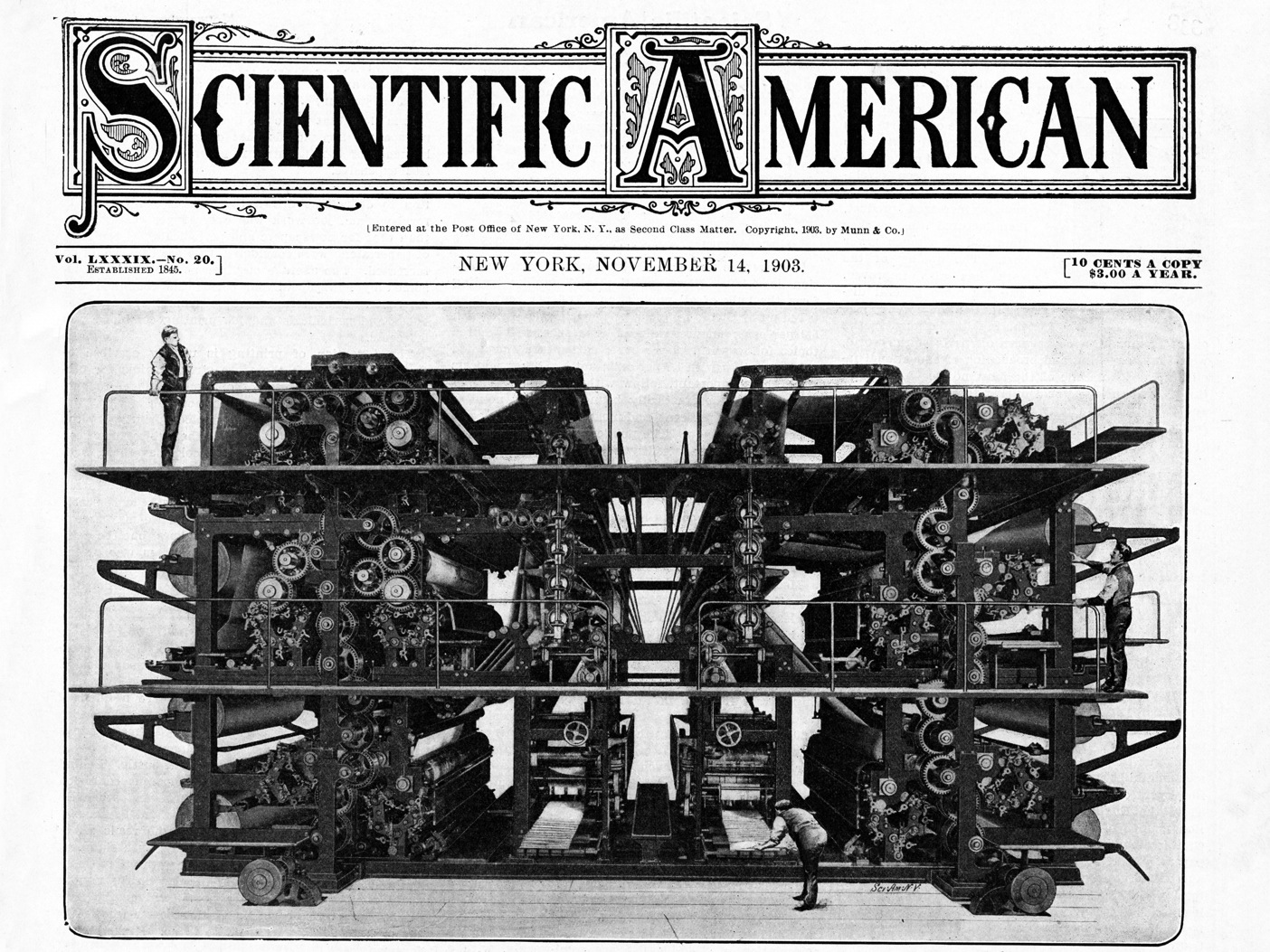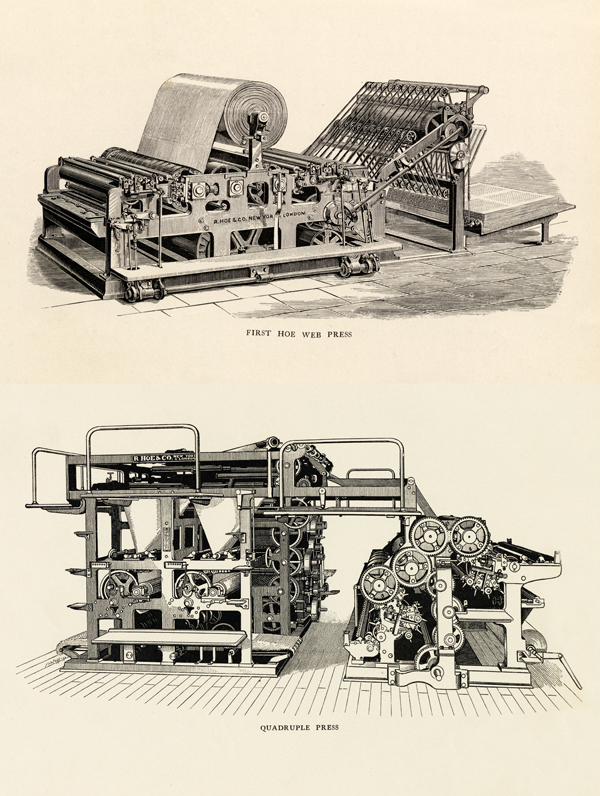The Skyscraper Museum is devoted to the study of high-rise building, past, present, and future. The Museum explores tall buildings as objects of design, products of technology, sites of construction, investments in real estate, and places of work and residence. This site will look better in a browser that supports web standards, but it is accessible to any browser or Internet device.
HISTORY OF THE PRESS

"Printing Machines--Sheet." Benjamin Butterworth, The Growth of
Industrial Art, 1888, p.152; engraving by Julius Bien & Co. Photo-lith NY.
Collection of the Skyscraper Museum.
The art of Printing was known forty centuries ago.
Ancient Assyrian and Egyptian seals exist whose surfaces were blacked and then pressed upon bark, a leaf or skin, thus delivering an impression, either with white marks on black ground or black on white ground, according to the character of the engraving. The kings of Egypt stamped their names upon their grants and orders. Tablets of clay were impressed by engraved cylinders, then baked. Some of the ancient stamps in the British Museum are of bronze, and have raised letters.
The first printed pages are found in the Chinese annals, 1120 B. C. DuHale supposed it to have been invented 930 B. C.
The Venetians introduced block printing.
The earliest impressions were taken by a mallet and smooth faced block of hard wood.
The oldest newspaper in the world is the King Pau, or Capital sheet, published in Pekin. It first appeared A. D. 911, but was issued irregularly until 1351. Since that date it was published weekly until June 4, 1832, when, by order of the reigning Emperor, it was converted into a daily, with three editions-morning, midday and evening. The issue is called Heing Pau (business sheet) and contains trade prices, exchange quotations and all manner of commercial intelligence. The daily edition varies from 13,000 to 14,000.
In the fifteenth century the art of printing by movable type was invented in Germany, and introduced into France, Italy and England.
Bleauw, of Amsterdam, made improvements on the printing presses in 1620.
The first printing press in the New World was used in Mexico, in the sixteenth century, by Spanish missionaries.
A mutilated copy of a book printed at that time by Juan Cromberger, is preserved in the library at Madrid, Spain. This press was used in Mexico in less than a century after the art became known in Europe, and nearly a century before its introduction into the United States.
The first press established in the United States as in Cambridge, Mass., in 1639. Rev. Jesse Glover was the first person who undertook the task of establishing a printing press in the United States. He raised the money for its purchase, went to England, bought it and had it shipped to Boston, Mass. He died on the return voyage to America. The Glover press was put in working order by S. Daye, who published the "Freeman's Oath," the first newspaper ever published in the American Colonies. He was succeeded by Samuel Green, who obtained a grant of 300 acres of land from the crown in encouragement for his zeal.

1903 Hoe Double Sextuple Press
Capacity: 150,000 eight-page newspapers an hour
Able to print color as well as black, the double sextuple combined enormous capacity with versatility.
Source: Scientific American, November 14, 1903
The first Indian printer known was employed in Massachusetts in the year 1639. An Indian boy was apprenticed to Green to learn the trade. He became an expert printer, and a worthy member of society, and took the name of James Printer. He rendered valuable aid in printing the Indian Bible. John Eliott said, "Printer was the only man who was able to compose the sheets and correct the press." The "Psalter," printed in 1709, bears the imprint: "By James Printer, for the Co., for the Propagation of the Gospel, &c."
The first family newspaper established in North America was in 1704.
The first negro who appeared in an American printing office was employed by Thomas Fleet, in Boston, Mass., in the year 1709.
The English and Indian languages were printed on the University Press, at Harvard, in 1709. About this time a printing press was established in New London, Conn.
James Franklin, a brother of Benjamin Franklin, established a periodical in Boston in 1721.
The first printing press south of Philadelphia, was set up at Annapolis, Md., in 1726.
Benjamin Franklin used the Bleauw press in London.
Nicholson patented a power press in 1790.
The first press west of Alleghany Mountains was located in Cincinnati, in 1793, and the first west of the Mississippi River, in St. Louis, in 1808.
In 1814, a German constructed a printing machine for the "London Times," this being the first newspaper printed by machinery driven by steam power.
In 1815, Cowper obtained a patent for curved electrotype plates to be affixed to a cylinder.

Top: 1873 Hoe Web Perfecting Press
Capacity: 12,000 eight-page newspapers an hour
This press printed from a roll of paper rather than individual sheets, which dramatically increased speed and capacity and reduced labor
Bottom: 1887 Hoe Quadruple Press
Capacity: 48,000 eight-page newspapers an hour
The Quadruple Press became the workhorse of the World and other large papers due to its large capacity at a time of quickly rising circulation figures.
Source: Robert Hoe, A Short History of the Printing Press, 1902
Clymer, of Philadelphia, invented the Cumberland hand press in 1817.
The first power printing press in the United States was invented by Dnaiel Treadwell, of Boston, in 1822.
The first lithographic establishment in the United States was established in Boston, Mass., in 1827.
The first important improvement of the Bleauw press was made by Earl Stanhope, in 1814, who invented a press made entirely of iron.
The Adams power press was invented in 1830, by Samuel Adams, of Boston, Mass.
Richard M. Hoe, of New York, first brought into practical use the rotary press, in 1847, and it was soon adopted by nearly all the daily papers in the country, and also in England, Scotland and Australia.
The perfected presses in use for printing the large newspapers, automatically feed, print, separate, fold and deliver many thousands an hour.
"Printing Machines--Sheet." Benjamin Butterworth, The Growth of Industrial Art, 1888, p.152; engraving by Julius Bien & Co. Photo-lith NY. Collection of the Skyscraper Museum.
